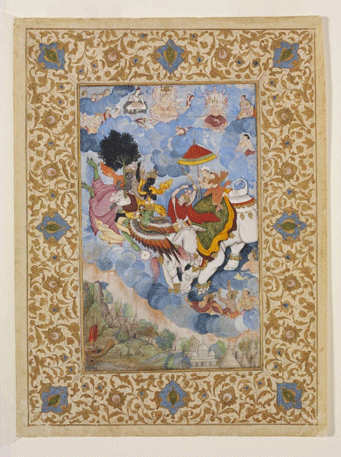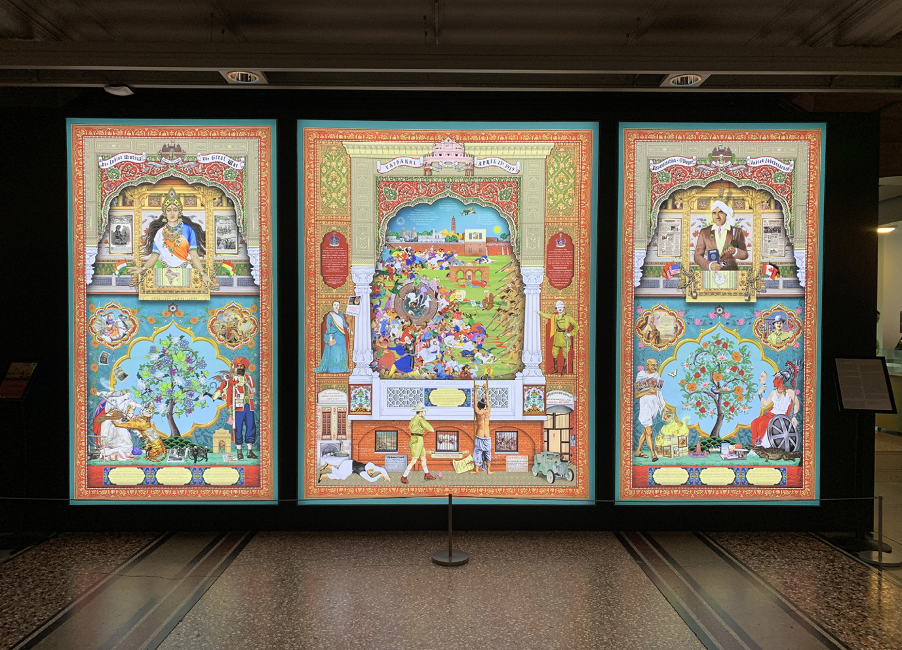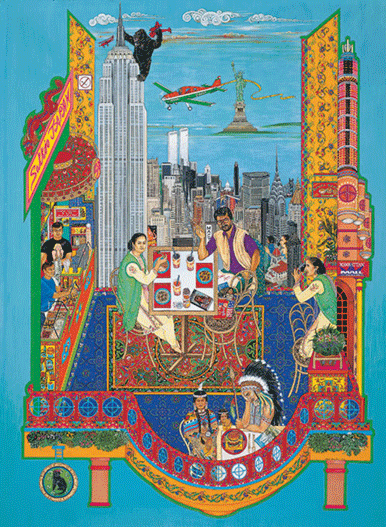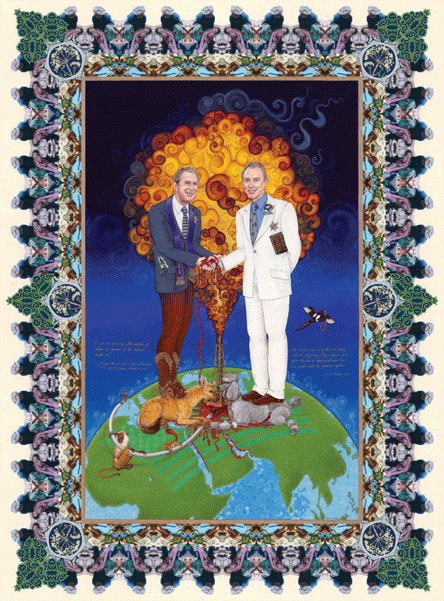In the fall of 2019, the V&A Museum in London hosted British artist Tim Walker’s Wonderful Things exhibition. The exhibition featured Walker’s vibrant photographs alongside a variety of rare art from all over the world, the whole displayed in a gallery of decorated rooms. Walker’s photographs were created with these older pieces in mind as a way to create a dialogue between old and new. The result spoke to the power of "recontextualization" in modern art. Specifically, it made a case for a historicized type of modern art; one that engages with older techniques and traditions; one that is in conversation with the past; one that creates new narratives by looking back.
This is something that artist duo the Singh Twins has consciously been inspired by throughout their illustrious career as painters. Sisters Rabindra and Amrit Singh grew up together in Liverpool in a large Indian Sikh family who raised them “with traditional customs, values and a proper convent education.” Today, they live together, paint together and often dress the same. What makes their art stand out is that it doesn’t necessarily conform to popular ideals of what can be considered modern art. In fact, the Singh Twins have often pointed out how inflexible and damaging preconceived notions about art can be. In an interview with The Guardian, Rabindra explains how throughout their studies they “were criticized for not being different enough.” Their response to this was to “challenge this western ideal of individuality by being the same.” The sisters aim to fight against the status quo, proving that modern art can be completely new and daringly provocative even when it honours past artistic traditions and heritage.

The Singh Twins achieve this by specializing in a very old style called miniature painting. They are particularly inspired by the aesthetic of the ancient tradition of Indian miniature painting, a practice that has been dated as far back as the ninth century. The style is recognizable by its intricate details and vibrant colours, often used to depict scenes from mythology, history and everyday life. Though the Indian miniature painting style spanned many centuries and schools of painting, its most prolific era was during the 16th century, which came to be known as the Mughal period. This style of painting was an “amalgamation of religion, culture and tradition”, often borrowing from Persian and Dutch techniques that were popular at the time according to Artisera.
Today, Indian miniature painting continues to be an important part of India's artistic heritage. The style has found its way back into the limelight thanks to the work of artists such as the twins as well as Wardha Shabbir, who has helped revive and modernize the style in Pakistan. Walker’s Wonderful Things has also contributed to the style’s presence in modern art, as many of the paintings from the V&A’s collection were displayed. According to the BBC, Walker’s series Cloud 9 was directly inspired by one painting from the 16th century entitled Krishna and Indra.

Nonetheless, the twins’ impact has been significant and their output is undeniably prolific. In 2005, they hosted a retrospective exhibition featuring around 90 of their paintings in their hometown of Liverpool. Part of the appeal is naturally found in the aesthetic of miniature painting - one that instils a sense of awe simply by considering the superhuman-like skills needed to paint such a piece. However, what is all the more striking is how politically charged their art is.
The Singh Twins channel their unique perspective to deliver thought-provoking pieces in which Western and Southern ideas intersect. There is an inherent rebellion in their paintings given that, as Murad Khan Mumtaz of the Guggenheim Museum explains, “the history of contemporary miniature painting is […] rooted in the history of colonialism in India.” The lingering legacy of colonialism is very much felt in their artwork. Growing up, they were confronted with the duality of England’s rich history of diversity through immigration and its subsequent difficult relationship with certain minority populations.
Discussing their 2019 commission for the Manchester Museum Jallianwala: Repression and Retribution, the artists explain how the piece depicts both the Jallianwala Bagh Massacre in India and the Peterloo Massacre in England. Speaking on the Manchester Museum’s podcast, they explain that they felt that the historical event “warranted some kind of artistic reflection” given that it “played such an important part in the way in which Britain and India relations developed” and was still completely erased in British history. Their committed portrayal of many untold stories and injustices through their art reflects the United Nation’s Sustainable Development Goal for Peace, Justice, and Strong Institutions.

The Singh Twins have often reiterated their rejection of Western conceptions of the self., “We were taught that self-expression and individualism were the be-all and end-all of modern art,” the sisters said in an interview with The Guardian. The Singh Twins have embraced ideals typically represented in the postmodern art movement; a philosophical theory that came to define much of the art produced between the 1980s and 1990s. Pieces by artists such as Jeff Koons, Andy Warhol, and Damien Hirst have been labelled postmodern for being “funny, tongue-in-cheek or ludicrous; […] confrontational and controversial and most importantly reflects “ a self-awareness of style itself.” Additionally, postmodernism makes a case for the loss of individuality in contemporary society, arguing that instead “minds are moulded through the prevailing culture.”
All of these elements are at play in the Singh Twins’ art. Their works simultaneously engage with fun elements of pop culture and deeply traumatic historical events, as seen in Jallianwala: Repression and Retribution, Partners in Crime: Deception and Lies, Manhattan Mall and many others. Their art fundamentally espouses the idea promoted by postmodern theorists that there aren’t any “universal certainties or truths” and that art should embrace “complex and often contradictory layers of meaning.”


Their deliberate use of traditional techniques to produce culturally relevant parodies of Indian miniature paintings underscores a certain self-awareness that is essential to postmodern art. The parallels between the Singh Twins’ artwork and postmodernism are all the more obvious when considering the fact that the sisters chose to call their 2005 exhibition Past Modern, a title that reflects their personal take on the movement.
Ultimately, the Singh Twins have pushed the definition of modern art into new territory. Ironically enough, they did this by looking back, reminding that what is considered “new” is never really new, that modern art is only really “past modern.”
